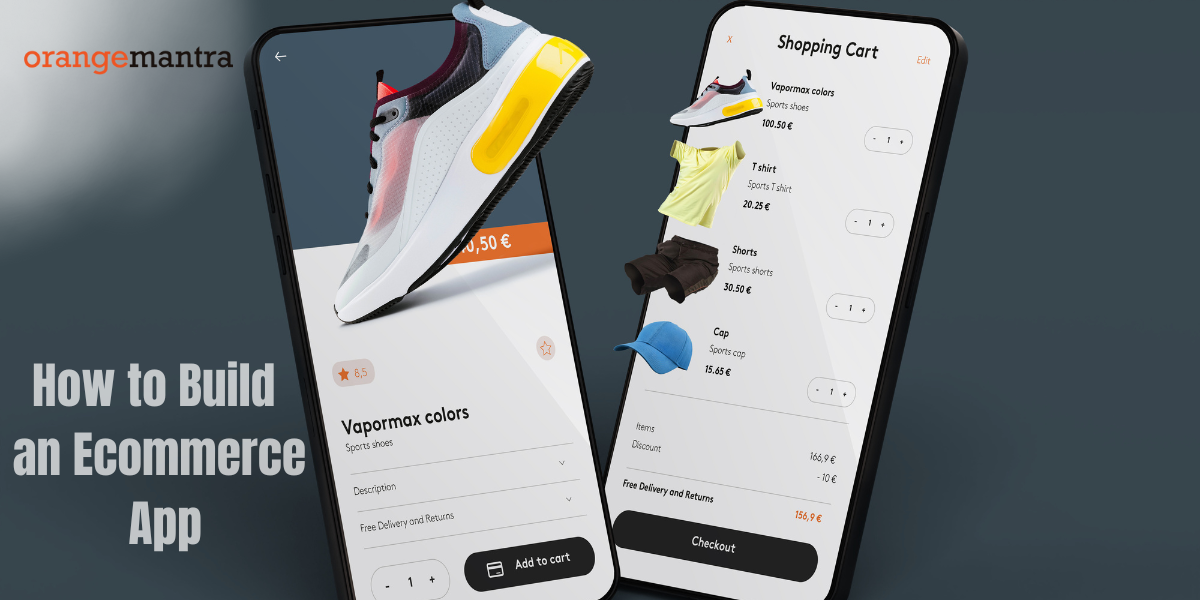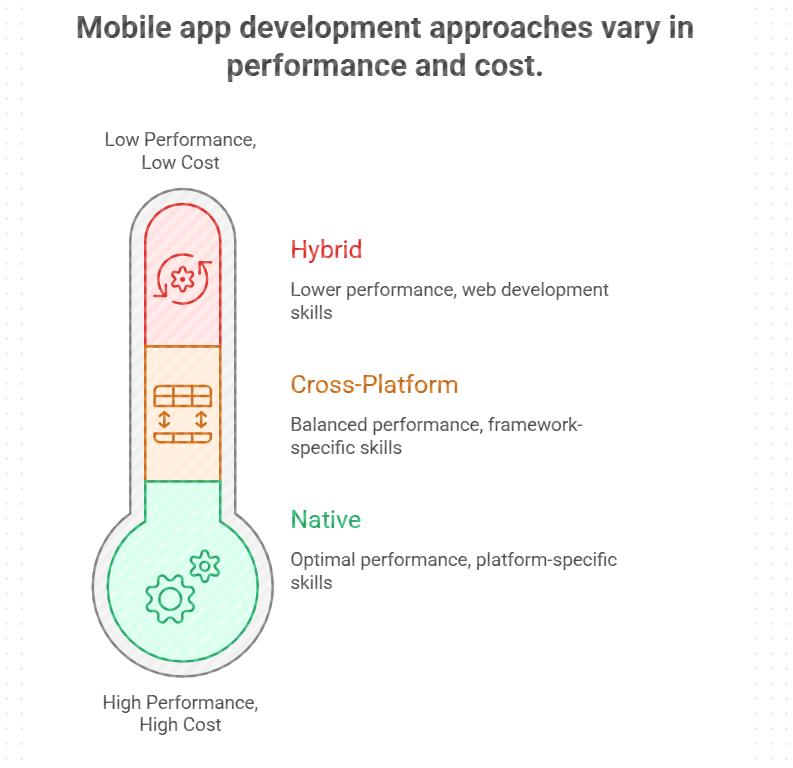
In this guide, you’ll discover everything you need to know to build a high-performing eCommerce mobile app in 2025. From must-have features like real-time inventory, secure payments, and AI-powered recommendations to the best development frameworks—native, cross-platform, and hybrid—we cover it all. You’ll also gain insights into cost breakdowns, budgeting tips, and the complete development process, so you can plan your app with confidence and ensure it drives sales, engagement, and long-term business growth.
Mobile devices now drive the majority of online commerce. Every industry is going digital with a new level of disruption. However, before putting your budget on any app, you must know what you need. A dedicated mobile app gives business buyers access to catalogs, real-time inventory, and order status. Plus, the eCommerce app development can streamline ordering and strengthen user relations. Let’s dive into knowing what it needs and costs for a B2B mobile app.
Table of Contents
How does mobile app development affect enterprise growth?
Mobile app development for eCommerce to create software apps for mobile devices. It involves designing, building, testing, and deploying apps tailored to iOS, Android, or cross-platform. With the growing shift towards mobile-first experiences, firms use mobile apps to engage users, streamline services, and drive revenue. From feature-rich native apps to cross-platform solutions, the development process includes multiple layers. Such as UI/UX design, backend integration, and performance optimization. Whether for eCommerce or entertainment, eCommerce application development services help businesses stay competitive.
A Quick Overview of the Mobile App Growth Statistics
- The global mobile app market size is expected to grow at a CAGR of 14.3%, with a projected estimation of $567.19 billion.
- Around 3.55 million Android apps are deployed in the Google Play Store.
- Around 93.5% of 5.3 billion global internet users and 88.4% of 5.6 billion smartphone users have social media accounts, out of which 61.4% of the global population is currently utilizing social media actively.
- Around 6 out of 10 people prefer to use online finance apps to manage their finances.
- The revenue of on-demand apps is expected to increase to $335 million by 2025.
- The OTT video marketplace is expected to reach US$419.90bn by 2028 at a CAGR of 6.58%.
Core Features of a B2B Commerce App
Here are the crucial features that offer the total eCommerce mobile app development cost.
- Corporate Account Hierarchies: Support multiple buyers under a single corporate account with distinct roles, budgets, and approvals. Gartner reports that B2B purchasing teams have 6–10 decision makers on average. Good apps let administrators set user permissions, approvals, and quote requests at the organization level.
- Bulk Ordering & Pricing: Business customers often order large quantities. Apps should offer easy reordering, order templates, volume discounts, and tiered pricing. Users must quickly add hundreds of items to a cart, or scan/invoice upload orders, to save time.
- Flexible Payment & Credit Terms: Unlike retail, B2B buyers may use net terms, purchase orders, or credit lines. The app should securely handle terms and integrate with company ledger systems.
- Rich Product Catalog & Search: Display detailed catalogs with robust filters. Support complex products and allow rich content (spec sheets, video demos, etc.). Since nearly 80% of B2B buyers struggle to find products online, advanced search (full-text, saved searches) is critical.
- Live Inventory & Order Status: Real-time stock levels must sync from ERP, so users never order out-of-stock items. Likewise, show order tracking and delivery updates to customers in-app. Many B2B clients are in the field and need up-to-date availability or lead times.
- Online Quotes & Approval Flows: B2B pricing often requires negotiation. The app should allow buyers to request quotes and enable sellers to review them before checkout. Integrating an in-app messaging can expedite back-and-forth clarification between the sales rep and buyer.
- Sales & Analytics Dashboard: Provide business users with reports on spend, order history, and product usage. Also include push notifications for expiring contracts or restocked items. Built-in analytics help the supplier optimize marketing and sales to each buyer.
- Offline & Sync Capabilities: In some industries, users may work without connectivity. A robust B2B app caches catalog data and collects order data offline, then syncs when online.
- Security & Compliance: Enterprise apps often require single sign-on (SSO) or two-factor authentication. Data encryption and compliance are must-haves to protect corporate data.
Choosing the Right Development Frameworks
Here is how you can choose the right approach for your applications.

- Native (iOS/Android separately): Develop one app in Swift/Objective-C for iOS and another in Kotlin/Java for Android. It maximizes performance and full access to device features. Native code can optimize complex B2B workflows, but requires maintaining two codebases. About 75% of B2B firms say mobile apps are “the future” of their industry.
- Cross-Platform (e.g., React Native, Flutter): Write one shared codebase that runs on both iOS and Android. Frameworks like React Native or Flutter allow “write once, run anywhere” coding, reducing development and maintenance effort. They still compile to native UI widgets and can approach native performance.
- Hybrid (Cordova/Ionic, etc.): Essentially a web app wrapped in a native shell. This approach can be the fastest to build and works on any mobile ecommerce platform, but often results in slower UI and less native feel. Hybrid is best suited for a quick MVP or an app that needs frequent web-like updates.
Cost Breakdown of Ecommerce Application Development
Let’s break down the costs of each step and requirement.
- App Complexity & Features: Every feature adds development, testing, and design time. For example, standard features like product browsing, cart, and checkout are inexpensive. But advanced capabilities require more hours. Building a complex B2B feature, like a live-quote module or a multi-currency wallet, will add to the cost.
- Platforms Targeted: Developing for iOS & Android natively generally costs twice as much as development. Cross-platform tools are used to create an app for both iOS and Android.
- Design & UX: A polished, responsive UI requires design expertise. A simple template design offers a few thousand dollars. Expect anywhere from $1.5K – $3K or more, depending on how much you customize. You can use an eCommerce mobile app developer for more assistance.
- Development Team Location: In-house or local agency developers (US/Western Europe) charge per hour. Outsourcing to Eastern Europe or India can reduce development costs by 30–50%. However, communication and time zone should be considered. A mixed team (local PM, offshore developers) is common to balance cost and quality.
- Testing & QA: Rigorous testing is crucial for a complex app. And functional, UX, performance, and security testing are also part of this process. Industry estimates put dedicated QA costs around $5K–$18K for a typical B2B app. Automated testing tools can reduce manual labor, but still require setup effort. Testing for compliance (e.g., PCI for payments) may also add cost.
- Maintenance & Updates: Plan for 15–20% of the initial development budget per year for hosting, updates, and support. After launch, you’ll patch bugs, update for new OS versions, and release new features. Budgeting for ongoing costs like cloud server fees, third-party APIs, push-notification services, etc., is essential.
- Hidden Costs: Now we come to the most crucial part about indirect expenses. It may include Apple’s App Store, Google Play Developer fees, SSL certificates, payment gateway fees, and marketing. You may also need to pay for a headless commerce backend or ERP licenses if not already owned. If scaling up your SaaS subscriptions, you may shift to higher tiers.
Budgeting Tips: Start with a clear MVP feature set to control initial costs, then phase in enhancements. Seek multiple quotes from experienced B2B app developers to compare scopes. Be transparent about your budget so partners can suggest the right tech (e.g., hybrid vs native) for your goals.
Step-by-Step Ecommerce Application Development Process
A typical enterprise app project follows stages of research, planning, design, development, testing, and launch. Each phase incurs time and cost:
- Research & Planning: Define target buyers, prioritize features (e.g., key integrations). And choose a technology stack (native vs cross, backend platform). Allocate time for prototyping and market validation.
- UX/UI Design: Create wireframes and clickable mockups. B2B apps may require detailed flows, so usability testing is important. A good design phase prevents costly scope changes later.
- Development: Teams work in sprints (Agile) to build ecommerce app features. Most companies cover Android and iOS support in parallel or via a cross-platform approach. It’s smart to integrate eCommerce and ERP systems early so that data flows correctly.
- Testing & QA: Continuously test during development. Functional testing catches bugs, while UX testing ensures ease of use. For B2B, also perform integration tests, simulate orders via the ERP, and check security compliance. As noted, building in automated tests reduces long-term cost and improves stability.
- Deployment & Launch: Prepare app store listings with optimized descriptions, screenshots, etc. Additionally, plan an internal rollout and marketing strategy to drive adoption. Expect each platform’s review process to take a week or more.
- Post-Launch: Monitor user feedback closely. Gather analytics on app usage and crashes. Roll out updates periodically to keep the app up to date. Failing to update regularly can hurt App Store ranking and leave users vulnerable, so allocate a maintenance budget.
Real-World B2B App Success Stories
The tablet app development provided walk-in customers with a user-friendly viewing experience.
Users can now browse through product catalogs, providing a smarter shopping experience.
Conclusion
For B2B enterprises, a mobile app is now as important as a store. The market is moving mobile-first: ignoring it risks losing ground to competitors who make ordering easier. Therefore, start with a clear vision and use experienced development partners to allocate budget for quality. Or you can consult a mobile commerce app development company for more assistance.
FAQs
Q1. How can an eCommerce app boost my sales and customer loyalty?
A mobile app gives your customers faster access, personalized experiences, and easy checkout, leading to higher engagement, repeat purchases, and stronger brand loyalty.
Q2. What features should my eCommerce app include to stay competitive?
Key features include AI-powered product recommendations, in-app chat support, real-time inventory, secure payments, and push notifications for offers and cart reminders.
Q3. How long does it take to build a fully functional eCommerce mobile app?
Typically, it takes 8–16 weeks, depending on app complexity, features, platform choice (iOS/Android), and backend integrations like payment gateways and inventory systems.
Q4. What’s the cost of developing a custom eCommerce app?
Costs vary based on design, feature set, and tech stack. On average, a high-quality eCommerce app ranges from $1.5K-$3K for small to mid-sized businesses.
Q5. Will my app be scalable as my business grows?
Yes. We build apps with scalable architecture and modular code so you can easily add new features, expand product lines, or go multi-region without major rebuilds.






